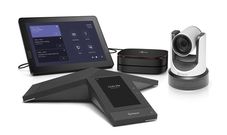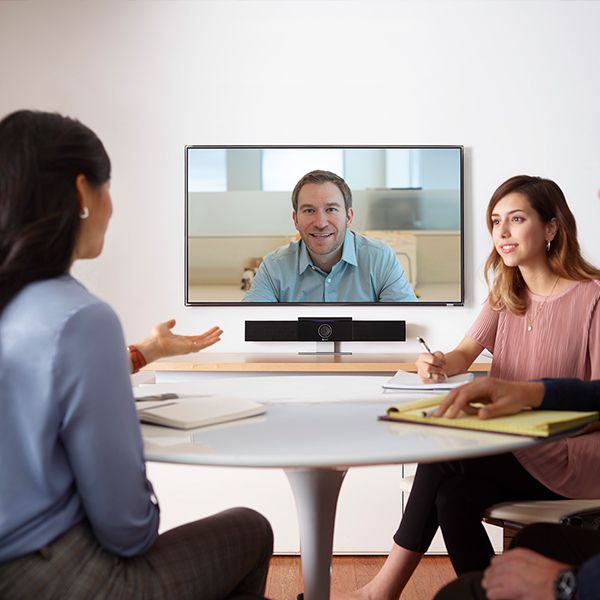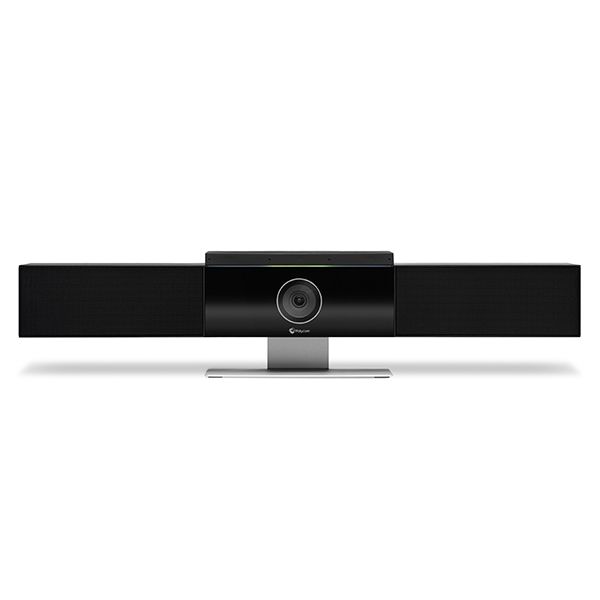Polycom studio polycom video conferencing

connection.
services carry many benefits. In businesses, they can increase productivity among employees, as well as provide an improved way of communicating

they can increase productivity among employees, as well as provide an improved way of communicating and interacting with colleagues, partners and customers.
For businesses, the tangible g include lower travel costs — especially, for employee training — and shortened meeting and project times as a result of improved communications among team members. Businesses can also increase revenue through higher quality virtual sales meetings.

Video conferencing is live, visual connection between two or more remote parties over the internet that simulates a face-to-face meeting. important because it joins people who would not normally be able to form a face-to-face connection. is important because it joins people who would not normally be able to form a face-to-face connection.
important because it joins people who would not normally be able to form a face-to-face connection.

important because it joins people who would not normally be able to form a face-to-face connection.
provides trans

mission of static images and text between two locations. At its most sophisticated, it provides transmission of full-motion video images and high-quality audio between multiple locations.

orld, desktop is a core component of unified communications platforms that also include calling and messaging capabilities.
Standalone on-premises and cloud-based video conferencing platforms are also available from numerous vendors who support desktop- and room-based video, as well as the ability to embed into business applications, such as Telehealth, customer service and distance learning.

The widespread availability of cloud-based services enables organizations to implement video conferencing with minimal upfront investment and to take advantage of rapidly emerging AI-powered features to improve audio and video performance.
The widespread availability of cloud-based services enables organizations to implement video conferencing with minimal upfront investment and to take advantage of rapidly emerging AI-powered features to improve audio and video performance.
The video conferencing process can be split into two steps: compression and transfer.
During compression, the camera and microphone capture analog audiovisual (AV) input. The data collected is in the form of continuous waves of frequencies and amplitudes. These represent the captured sounds, colors, brightness, depth and shades. Once captured, codecs convert data into digital packets, typically with compression to minimize bandwidth usage.
During the transfer phase, packets are sent over the network, typically to the cloud service provider, which then transmits them to other conference participants (and combines voice and video from multiple participants).
The components of a video conferencing system include the following:
- A network for data transfer, such as wired/wireless local area network, wide area network, cellular wireless and residential broadband.
- Two or more video cameras or webcams that provide video input.
- To or more microphones — either an external microphone or one built into the accessing device.
- A computer screen, monitor, TV or projector that can broadcast video output.
- Headphones, laptop speakers or external speakers that can be used for audio output.
- Codecs, which can be hardware- or software-based, to reduce bandwidth by compressing and decompressing AV data. They typically include acoustic echo cancellation capabilities, which reduce audio delays to support real-time communication. Codecs may also include features like noise cancellation and acoustic fencing to minimize background noise during conferences.
- that also include calling and messaging capabilities.
Polycom Studio | Polycom Video Conferencing

Polycom Studio
Meet Polycom Studio, the premium USB video bar built for small rooms and big ideas. Delivering the best audio quality in its class, it blocks distracting sounds that can interrupt meetings. Teams on both ends of the call catch every word. With group framing and automatic speaker tracking, the connection feels personal with polycom studio. They see
all the details, right down to body language and facial expressions. Easy to manage? Of course. The cloud-based management tools let IT push software updates and make changes without leaving their desk. Polycom Studio. The shortcut to better huddle room collaboration.
- USB Video Bar built for small rooms and big ideas
- Acoustic Fence keeps voices outside the room from interrupting your calls
- Up to 3.7 m/12 ft microphone pickup range
- Smart-camera experiences are built in—no drivers or software needed
- Centralized management enables high-scale deployments
- Works with nearly any video platform
Poly Studio Highlights
- You’ve never heard a USB video bar sound this good. Polycom Studio has the absolute best audio quality and voice clarity in its class
- Distracting sounds are eliminated by our patented NoiseBlock technology
- Be more productive on both ends of your video conference with a smart camera that automatically frames the room or tracks the person speaking for deeper engagement
- Eliminate “sneakernet” with centralized management, enabling high-scale deployments without added burden on IT

Polycom Studio Specifications
Dimensions
- Unit dimensions:
105 mm x 700 mm x 70 mm =
4.2″ x 27.3″ x 2.8″ (HxWxD) without stand
156 mm x 700 mm x 70 mm =
6.2″ x 27.3″ x 2.8″ (HxWxD) with stand - Weight:
5 lbs 2.6 oz (2342 g) without stand 6 lbs 4.7 oz (2856 g) with stand - Remote control dimensions:
183 mm x 40 mm x 19 mm = 7.2″ x 1.6″ x .75″ (HxWxD)
Camera
- 5x zoom / EPTZ
- 120° FOV
- UHD 2160p (4K) capture resolution
- Automatic people framing & speaker tracking
- 2 camera presets
Audio
- Polycom Acoustic Clarity technology provides full-duplex conversations, acoustic echo cancellation and background noise suppression
- NoiseBlock technology
- Acoustic Fence technology
- Mute/unmute controls
- Stereo microphones:
6-element beamforming microphone array
12 ft pickup range
120 Hz–16 kHz frequency response - Stereo speakers:
100 Hz–20 KHz frequency response Output = 90 dB @ 0.5m
Polycom Studio is compatible with nearly any cloud-based video platform
